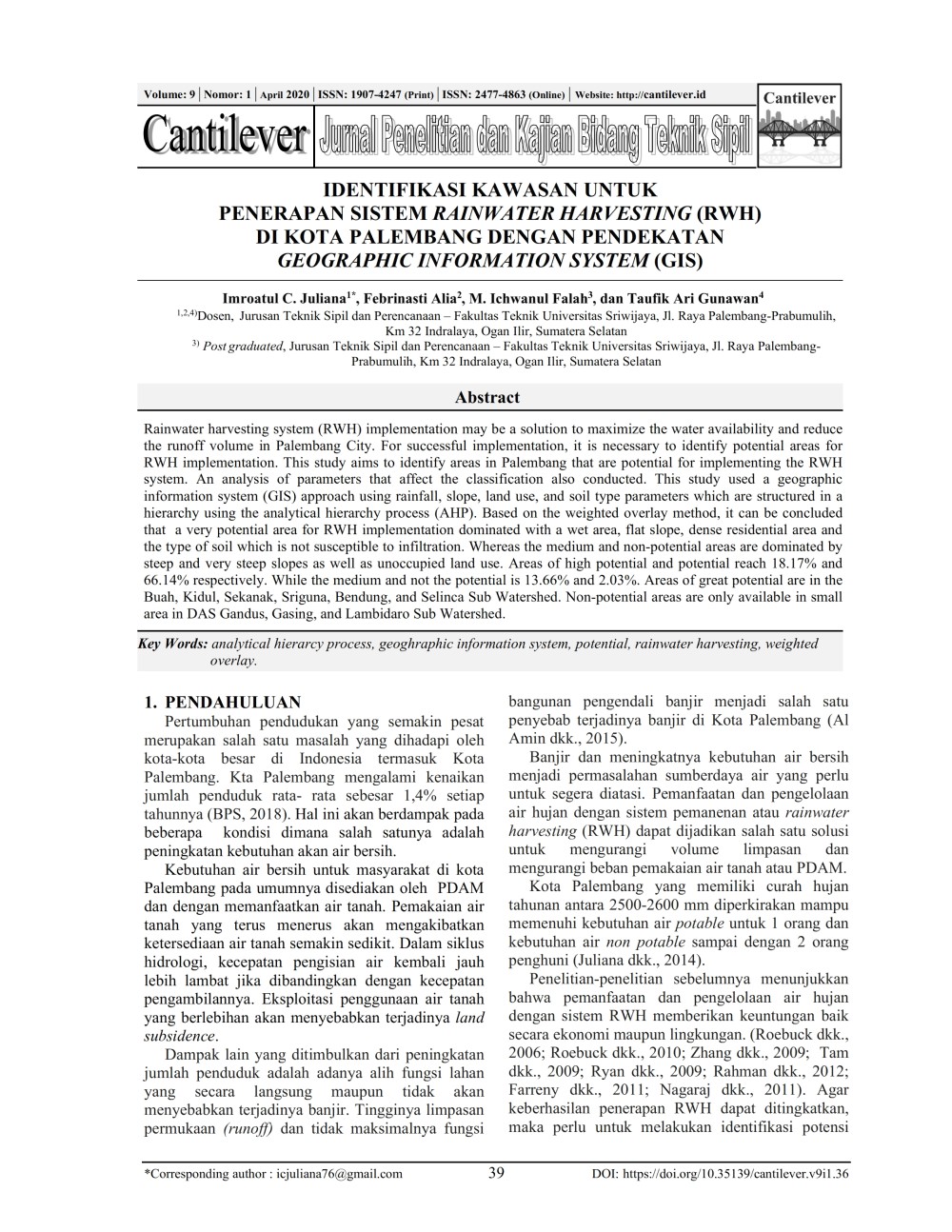Identifikasi Kawasan Potensial Untuk Penerapan Sistem Rainwater Harvesting (RWH) di Kota Palembang dengan Pendekatan Geographic Information System (GIS) Identification of Potential Areas for Implementation of Rainwater Harvesting (RWH) System in Palembang City with Geographic Information System (GIS) Approach
Main Article Content
Abstract
Rainwater harvesting system (RWH) implementation may be a solution to maximize the water availability and reduce the runoff volume in Palembang City. For successful implementation, it is necessary to identify potential areas for RWH implementation. This study aims to identify areas in Palembang that are potential for implementing the RWH system. An analysis of parameters that affect the classification also conducted. This study used a geographic information system (GIS) approach using rainfall, slope, land use, and soil type parameters which are structured in a hierarchy using the analytical hierarchy process (AHP). Based on the weighted overlay method, it can be concluded that a very potential area for RWH implementation dominated with a wet area, flat slope, dense residential area and the type of soil which is not susceptible to infiltration. Whereas the medium and non-potential areas are dominated by steep and very steep slopes as well as unoccupied land use. Areas of high potential and potential reach 18.17% and 66.14% respectively. While the medium and not the potential is 13.66% and 2.03%. Areas of great potential are in the Buah, Kidul, Sekanak, Sriguna, Bendung, and Selinca Sub Watershed. Non-potential areas are only available in small area in DAS Gandus, Gasing, and Lambidaro Sub Watershed.
Downloads
Article Details
Al Amin, M. Baitullah dkk. 2015. Visualisasi Potensi Genangan Banjir Di Sungai Lambidaro Melalui Penelusuran Aliran Menggunakan HEC-RAS. Seminar Nasional Teknik Sipil I (SeNaTS I), Denpasar, Bali, 25 April 2015.
Bappeda Litbang Kota Palembang, (2017). Standarisasi Harga Satuan Upah, Bahan Dan Gedung Kota Palembang
BPS, (2018), Kota Palembang dalam Angka. BPS.
Darmawan, Kurnia dkk. (2017). Analisis Tingkat Kerawanan Banjir di Kabupaten Sampang Menggunakan Metode Overlay dengan Scoring Berbasis Sistem Informasi Geografis. Semarang: Jurnal Geodesi Undip. 6(1), 31-40, Semarang.
Farreny, R., Gabarrell, X., dan Rieradevall, J. (2011). Cost efficiency of rainwater harvesting strategies in dense mediterranean neighbourhoods, Journal of Resources, Conservation and Recycling, 55, 686-694, Netherlands.
Mahmoud, Shereif H. dkk. (2015). GIS Methods for Sustainable Stormwater Harvesting and Storage Using Remote Sensing for Land Cover Data – Location Assessment. Environ Monit Assess.187(9):598. https://doi: 10.1007/s10661-015-4822-x
Nagaraj, N., Pradhani, U., Chengappa, P.G. (2011): Cost effectiveness of rainwater harvesting for groundwater recharge in micro watersheds of kolar district india, Agricultural Economics Research Review, 24, 217-223, India.
Nketiaa, Abrefa K. (2013). Using A Gis-Based Model as A Decision Support Framework for Identifying Suitable Rain Water Harvesting Sites. International Journal of Advanced Technology & Engineering Research (IJATER). 25-33.
Juliana, Imroatul dkk, (2014). Analisa Potensi Curah Hujan untuk Penerapan Sistem Rainwater Harvesting di Kota Palembang, Prosiding Seminar Nasional Teknik Sipil X, 667 – 676, Surabaya, 10 November 2014.
Juliana, Imroatul dkk (2017). Performance of rainwater harvesting system based on roof catchment area and storage tank capacity, MATEC Web of Conferences 101, https://doi.org/10.1051/matecconf/201710105014
Rahman, A., Keane, J., dan Imteaz M.A. (2012): Rainwater harvesting in greater sydney : water savings, reability and economic benefits, Journal of Resources, Conservation and Recycling, 61, 16 - 21, Netherlands.
Roebuck, R.M., dan Ashley (2006), Predicting the hydraulic and life cycle cost performance of rainwater harvesting sistem using a computer based modelling tool, Proceeding 7th International Conference of Urban Drainage Modelling, Australia.
Roebuck, R.M., Dumbrava, Tait (2010). Whole life cost performance of domestic rainwater harvesting systems in the Unite Kingdom, Water and Environment Journal¸ 25 (3), 355-365.
Ryan, M.A., Spash, C.L., dan Measham, T.G., (2009). Socio-economic and psycological predictors of domestic greywater and rainwater collection : evidence from australia, Journal of Hydrology, 379, 164-171, Netherlands.
Vivian, Tam, L., dan S.X., Zeng (2009). Cost Effectiveness and Tradeoff on the Use of Rainwater Tank : An empirical study in Australian residential decision-making, Journal of Resources, Conservation and Recycling, 54, 178-186, Netherlands.
Zhang, Y., Chen, D., Chen, L., dan Ashbolt, S. (2009). Potential for rainwater use in high rise buildings in australian cities, Journal of Environmental Management, 91, 222-226, United States.

This work is licensed under a Creative Commons Attribution-NonCommercial 4.0 International License.
Authors who publish with this journal agree to the following terms:
- Authors retain copyright and grant the journal right of first publication with the work simultaneously licensed under a Creative Commons Attribution-NonCommercial 4.0 International License that allows others to share the work with an acknowledgment of the work's authorship and initial publication in this journal.
- Authors are able to enter into separate, additional contractual arrangements for the non-exclusive distribution of the journal's published version of the work (e.g., post it to an institutional repository or publish it in a book), with an acknowledgment of its initial publication in this journal.
- Authors are permitted and encouraged to post their work online (e.g., in institutional repositories or on their website) prior to and during the submission process, as it can lead to productive exchanges, as well as earlier and greater citation of published work (See The Effect of Open Access).
